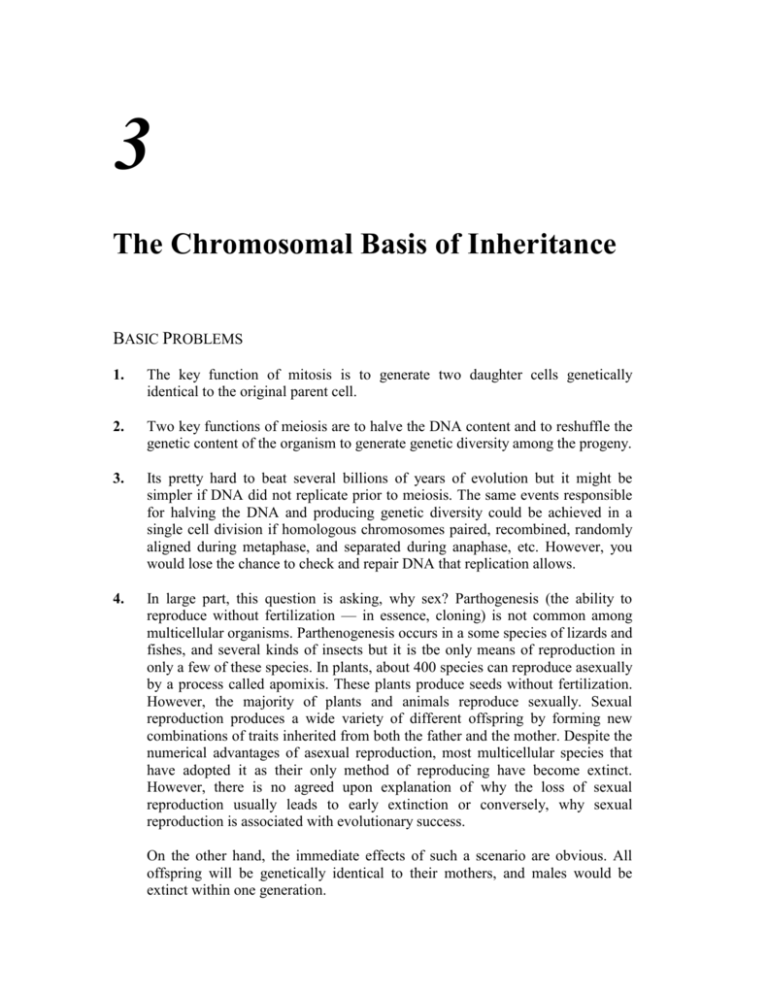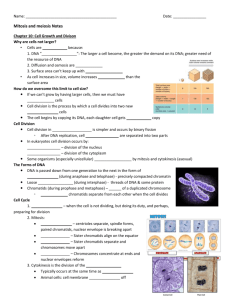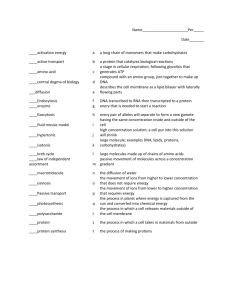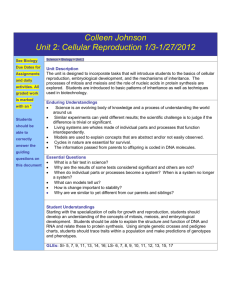IGA 8/e Chapter 3
advertisement

3 The Chromosomal Basis of Inheritance BASIC PROBLEMS 1. The key function of mitosis is to generate two daughter cells genetically identical to the original parent cell. 2. Two key functions of meiosis are to halve the DNA content and to reshuffle the genetic content of the organism to generate genetic diversity among the progeny. 3. Its pretty hard to beat several billions of years of evolution but it might be simpler if DNA did not replicate prior to meiosis. The same events responsible for halving the DNA and producing genetic diversity could be achieved in a single cell division if homologous chromosomes paired, recombined, randomly aligned during metaphase, and separated during anaphase, etc. However, you would lose the chance to check and repair DNA that replication allows. 4. In large part, this question is asking, why sex? Parthogenesis (the ability to reproduce without fertilization — in essence, cloning) is not common among multicellular organisms. Parthenogenesis occurs in a some species of lizards and fishes, and several kinds of insects but it is tbe only means of reproduction in only a few of these species. In plants, about 400 species can reproduce asexually by a process called apomixis. These plants produce seeds without fertilization. However, the majority of plants and animals reproduce sexually. Sexual reproduction produces a wide variety of different offspring by forming new combinations of traits inherited from both the father and the mother. Despite the numerical advantages of asexual reproduction, most multicellular species that have adopted it as their only method of reproducing have become extinct. However, there is no agreed upon explanation of why the loss of sexual reproduction usually leads to early extinction or conversely, why sexual reproduction is associated with evolutionary success. On the other hand, the immediate effects of such a scenario are obvious. All offspring will be genetically identical to their mothers, and males would be extinct within one generation. 42 Chapter Three 5. As cells divide mitotically, each chromosome consists of identical sister chromatids that are separated to form genetically identical daughter cells. Although the second division of meiosis appears to be a similar process, the “sister” chromatids are likely to be different. Recombination during earlier meiotic stages has swapped regions of DNA between sister and nonsister chromosomes such that the two daughter cells of this division typically are not genetically identical. 6. a. Because the sister-chromatids have not separated, the cell is undergoing meiosis I. As the dyads are at the poles, the cell is at the end of anaphase I. b. Each chromosome will have been replicated and each would contain two sister-chromatids. The replicated chromosome becomes the visible bivalent during prophase I of meiosis. So, an organism with 14 chromosomes will have 14 bivalents. 7. Note: The octad illustrated in (a) happens to have no crossover in the region between the centromere and the gene being followed. A crossover here would change the pattern of ascospores in the ascus but would not effect the 1:1 ratio of alleles in the meiotic products. 8. The four stages of mitosis are: prophase, metaphase, anaphase, and telophase. The first letters, PMAT, can be remembered by a mnemonic such as: Playful Mice Analyze Twice. The five stages of prophase I are: leptotene, zygotene, pachytene, diplotene, and diakinesis. The first letters, LZPDD, can be remembered by a mnemonic such as: Large Zoos Provide Dangerous Distractions. Chapter Three 43 9. Each diploid meiocyte undergoes meiosis to form four products and then each undergoes a postmeiotic mitotic division to give a total of eight ascospores per meiocyte. In total then, 100 meiocytes will give rise to 800 ascospores. 10. The resulting cells will have the identical genotype as the original cell: A/a ; B/b. 11. Yes. It could work but certain DNA repair mechanisms (such as postreplication recombination repair) could not be invoked prior to cell division. There would be just two cells as products of this meiosis, rather than four. 12. The general formula for the number of different male/female centromeric combinations possible is 2n, where n = number of different chromosome pairs. In this case, 25 = 32. 13. Because the DNA levels vary six-fold, the range covers cells that are haploid (spores or cells of the gametophyte stage) to cells that are triploid (the endosperm) and dividing (after DNA has replicated but prior to cell division). The following cells would fit the DNA measurements: 0.7 1.4 2.1 2.8 4.2 14. haploid cells diploid cells in G1 or haploid cells after S but prior to cell division triploid cells of the endosperm diploid cells after S but prior to cell division triploid cells after S but prior to cell division Parent cell a+ a+ b a+ a+ b b Chromosome duplication b a+ a+ b b a+ b Segregation Daughter cells 15. PFGE separates DNA molecules by size. When DNA is carefully isolated from Neurospora (which has seven different chromosomes) seven bands should be produced using this technique. Similarly, the pea has seven different 44 Chapter Three chromosomes and will produce seven bands (homologous chromosomes will co-migrate as a single band). 16. There is a total of 4 m of DNA and nine chromosomes per haploid set. On average, each is 4/9 m long. At metaphase, their average length is 13 µm, so the average packing ratio is 13 10–6 m : 4.4 10–1 m or roughly 1:34,000! This remarkable achievement is accomplished through the interaction of the DNA with proteins. At its most basic, eukaryotic DNA is associated with histones in units called nucleosomes and during mitosis, coils into a solenoid. As loops, it associates with and winds into a central core of nonhistone protein called the scaffold. 17. The nucleus contains the genome and separates it from the cytoplasm. However, during cell division, the nuclear envelope dissociates (breaks down). It is the job of the microtubule-based spindle to actually separate the chromosomes (divide the genetic material) around which nuclei reform during telophase. In this sense, it can be viewed as a passive structure that is divided by the cell’s cytoskeleton. 18. Yes. Half of our genetic makeup is derived from each parent, each parent’s genetic makeup is derived half from each of their parents, etc. 19. Because the “half” inherited is very random, the chances of receiving exactly the same half is vanishingly small. Ignoring recombination and focusing just on which chromosomes are inherited from one parent (for example, the one they inherited from their father or the one from their mother?), there are 223 = 8,388,608 possible combinations! 20. Remember, the endosperm is formed from two polar nuclei (which are genetically identical) and one sperm nucleus. Female s/s S/S S/s Male S/S s/s S/s Polar nuclei s and s S and S 1/ S and S 2 1/ 21. a. 2 s and s Sperm S s 1/ S 2 1/ 2 s Endosperm S/s/s S/S/s 1/ S/S/S 4 1/ S/S/s 4 1/ S/s/s 4 1/ s/s/s 4 A sporophyte of A/a ; B/b genotype will produce gametophytes in the following proportions: 1/ A ; B 4 1/ A ; b 4 1/ a ; B 4 1/ a ; b 4 Chapter Three 45 b. Random fertilization of the spores from the above gametophytes can occur 4 4 = 16 possible ways. Four of these combinations (A ; B a ; b, a ; b A ; B, A ; b a ; B, a ; BA ; b) will result in the desired A/a ; B/b sporophyte genotype. Therefore 1/4 of next generation should be of this genotype. 22. All daughter cells will still be A/a ; B/b ; C/c. Mitosis generates daughter cells genetically identical with that of the original cell. 23. ad– ; a ad+ ; P Transient diploid F1 24. ad+/ad– ; a/ 1/ ad+ ; a, white 1/ ad– ; a, purple 4 1/ ad+ ; , white 4 1/ ad– ; , purple 4 4 fern Mitosis sporophyte gametophyte Meiosis sporophyte (sporangium) moss sporophyte sporophyte (atheridium and archegonium) gametophyte 25. plant sporophyte gametophyte sporophyte (anther and ovule) pine tree sporophyte gametophyte sporophyte (pine cone) mushroom sporophyte gametophyte sporophyte (ascus or basidium) frog somatic cells gonads butterfly somatic cells gonads snail somatic cells gonads This problem is tricky because the answers depend on how a cell is defined. In general, geneticists consider the transition from one cell to two cells to occur with the onset of anaphase in both mitosis and meiosis, even though cytoplasmic division occurs at a later stage. a. 46 chromosomes, each with two chromatids = 92 chromatids 46 Chapter Three b. 46 chromosomes, each with two chromatids = 92 chromatids c. 46 physically separate chromosomes in each of two about-to-be-formed cells d. 23 chromosomes in each of two about-to-be-formed cells, each with two chromatids = 46 chromatids e. 23 chromosomes in each of two about-to-be-formed cells 26. (5) chromosome pairing (synapsis) 27. His children will have to inherit the satellite-containing 4 (probability = 1/2), the abnormally-staining 7 (probability = 1/2), and the Y chromosome (probability = 1/ ). To get all three, the probability is (1/ )(1/ )(1/ ) = 1/ . 2 2 2 2 8 28. The parental set of centromeres can match either parent, which means there are two ways to satisfy the problem. For any one pair, the probability of a centromere from one parent going into a specific gamete is 1/2. For n pairs, the probability of all the centromeres being from one parent is (1/2)n. Therefore, the total probability of having a haploid complement of centromeres from either parent is 2(1/2)n = (1/2)n–1. 29. Dear Monk Mendel: I have recently read your most engrossing manuscript detailing the results of your most wise experiments with garden peas. I salute both your curiosity and your ingenuity in conducting said experiments, thereby opening up for scientific exploration an entire new area of our Maker’s universe. Dear Sir, your findings are extraordinary! While I do not pretend to compare myself to you in any fashion, I beg to bring to your attention certain findings I have made with the aid of that most fascinating and revealing instrument, the microscope. I have been turning my attention to the smallest of worlds with an instrument that I myself have built, and I have noticed some structures that may parallel in behavior the factors which you have postulated in the pea. I have worked with grasshoppers, however, not your garden peas. Although you are a man of the cloth, you are also a man of science, and I pray that you will not be offended when I state that I have specifically studied the reproductive organs of male grasshoppers. Indeed, I did not limit myself to studying the organs themselves; instead, I also studied the smaller units that make up the male organs and have beheld structures most amazing within them. Chapter Three 47 These structures are contained within numerous small bags within the male organs. Each bag has a number of these structures, which are long and threadlike at some times and short and compact at other times. They come together in the middle of a bag, and then they appear to divide equally. Shortly thereafter, the bag itself divides, and what looks like half of the threadlike structures goes into each new bag. Could it be, Sir, that these threadlike structures are the very same as your factors? I know, of course, that garden peas do not have male organs in the same way that grasshoppers do, but it seems to me that you found it necessary to emasculate the garden peas in order to do some crosses, so I do not think it too far-fetched to postulate a similarity between grasshoppers and garden peas in this respect. Pray, Sir, do not laugh at me and dismiss my thoughts on this subject even though I have neither your excellent training nor your astounding wisdom in the Sciences. I remain your humble servant to eternity! 30. When results of a cross are sex-specific, sex linkage should be considered. In moths, the heterogametic sex is actually the female while the male is the homogametic sex. Assuming that dark (D) is dominant to light (d), then the data can be explained by the dark male being heterozygous (D/d) and the dark female being hemizygous (D). All male progeny will inherit the D allele from their mother and therefore be dark while half the females will inherit D from their father (and be dark) and half will inherit d (and be light). 31. a. Both the gametophyte and the sporophyte are closer in shape to the mother than the father. Note that a size increase occurs in each type of cross. b. Gametophyte and sporophyte morphology are affected by extranuclear factors. Leaf size may be a function of the interplay between nuclear genome contributions. c. If extranuclear factors are affecting morphology while nuclear factors are affecting leaf size, then repeated backcrosses could be conducted, using the hybrid as the female. This would result in the cytoplasmic information remaining constant while the nuclear information becomes increasingly like that of the backcross parent. Leaf morphology should therefore remain constant while leaf size would decrease toward the size of the backcross parent. 32. The goal here is to generate a plant with the cytoplasm of plant A and the nuclear genome predominantly of plant B. Remember that the cytoplasm is contributed by the egg only. So using plant A as the maternal parent, cross to B (as the paternal parent) and then backcross the progeny of this cross using plant B again as the paternal parent. Repeat for several generations until virtually the entire nuclear genome is from the B parent. 48 Chapter Three 33. If the variegation is due to a chloroplast mutation, then the phenotype of the offspring will be controlled solely by the phenotype of the maternal parent. Look for flowers on white branches and test to see if they produce seeds that grow into all white plants regardless of the source of the pollen. To test whether a dominant nuclear mutation is responsible for the variegation, cross pollen from flowers on white branches to green plants (or flowers on green branches of same plant) and see if half the progeny are white and half are green (assuming the dominant mutation is heterozygous) or all white, if the dominant mutation is homozygous. 34. Progeny plants inherited only normal cpDNA (lane 1); only mutant cpDNA (lane 2); or both (lane 3). In order to get homozygous cpDNA, seen in lanes 1 and 2, segregation of chloroplasts had to occur. Chapter Three 49 CHALLENGING PROBLEMS 35. In the following schematic drawings, chromosomes (or chromatids) that are radioactive are indicated be the grains that would be observed after radioautography. After the second mitotic division, a number of outcomes are possible due to the random alignment and separation of the radioactive and nonradioactive chromatids. * * * ** * ** ** ** *** * * * ** ** ** * ** ** ** * ** ** * * * * * ** * ** * ** ** * ** ** * * * ** ** ** * ** **** * ** * * * ** ** * * Prophase of first mitosis Telophase of first mitosis * * * * * * * ** * * * * * * * * * * * * * * * * * ** ** * ** * ** ** * * * * * ** * * * * * ** * ** * * * ** * * * * * * ** * * * * * ** * * * * ** ** Prophase of second mitosis * ** ** ** * * * * * ** ** * * * ** * * * *** * * * * * * * ** * * * * * ** * Chapter Three * * * * * ** * * * * ** * * ** * * ** Probability 1/8 and OR * * * * * ** * * * * ** and * * * * * * ** * * * * * ** * * * * * * * * * * * ** * 1/4 OR ** * * * ** * * ** ** ** * * ** ** * * * * * * * and * * * * * ** * * * * ** * 1/ 4 OR * and 1/4 * * * ** ** * * * * * ** * * * ** OR and ** * * * ** * * * ** ** * * * * ** * * * * * * * * * * * ** * * * * * * ** * * * * * * * * * * * * * * * * * * * * ** * Telophase of second mitosis * * * ** * * * * * * * * ** * * * * ** 50 1/8 Chapter Three 51 36. 37. a. In a diploid cell, expect two chromosomes (a pair of homologs) to each have a single locus of radioactivity. b. Expect many regions of radioactivity scattered throughout the chromosomes. The exact number and pattern would be dependent on the specific sequence in question, and where and how often it is present within the genome. c. The multiple copies of the genes for ribosomal RNA are organized into large tandem arrays called nucleolar organizers (NO). Therefore, expect broader areas of radioactivity compared to (a). The number of these regions would equal the number of NO present in the organism. d. Each chromosome end would be labeled by telomeric DNA. e. The multiple repeats of this heterochromatic DNA are organized into large tandem arrays. Therefore, expect broader areas of radioactivity compared to (a). Also, there may be more than one area in the genome of the same simple repeat. 52 Chapter Three 38. The following is meant to be examples of what is possible. It is also possible, for instance, that more than one band would be present in (a), depending on the position of the restriction sites within the sequence complementary to the probe used. a b c For (d) and (e), the specifics or where the DNA is cut relative to the telomeric DNA or heterochromatic DNA will effect what is observed. Assuming the restriction sites are not within the telomeric or heterochromatic DNA, then (d) will be similar to (b), and (c) will have one or several very large bands. 39. First, examine the crosses and the resulting genotypes of the endosperm: Female Male Polar nuclei Sperm Endosperm ƒ´/ƒ´ (floury) ƒ´´/ƒ´´ ƒ´ and ƒ´ ƒ´´/ƒ´´ ƒ´/ƒ´/ƒ´´ ƒ´´/ƒ´´ (flinty) ƒ´/ƒ´ ƒ´´ and ƒ´´ ƒ´/ƒ´ ƒ´´/ƒ´´/ƒ´ As can be seen, the phenotype of the endosperm correlates to the predominant allele present. 40. (1) (2) Impossible: the alleles of the same genes are on nonhomologous chromosomes Meiosis II Chapter Three 53 (3) (4) (5) (6) (7) (8) (9) (10) (11) (12) Meiosis II Meiosis II Mitosis Impossible: appears to be mitotic anaphase but alleles of sister chromatids are not identical Impossible: too many chromosomes Impossible: too many chromosomes Impossible: too many chromosomes Meiosis I Impossible: appears to be meiosis of homozygous a/a ; B/B Impossible: the alleles of the same genes are on nonhomologous chromosomes 41. Recall that each cell has many mitochondria, each with numerous genomes. Also recall that cytoplasmic segregation is routinely found in mitochondrial mixtures within the same cell. The best explanation for this pedigree is that the mother in generation I experienced a mutation in a single cell that was a progenitor of her egg cells (primordial germ cell). By chance alone, the two males with the disorder in the second generation were from egg cells that had experienced a great deal of cytoplasmic segregation prior to fertilization, while the two females in that generation received a mixture. The spontaneous abortions that occurred for the first woman in generation II were the result of extensive cytoplasmic segregation in her primordial germ cells: aberrant mitochondria were retained. The spontaneous abortions of the second woman in generation II also came from such cells. The normal children of this woman were the result of extensive segregation in the opposite direction: normal mitochondria were retained. The affected children of this woman were from egg cells that had undergone less cytoplasmic segregation by the time of fertilization, so that they developed to term but still suffered from the disease. 42. For the following, S will signify cytoplasm of a male-sterile line and N will signify cytoplasm of a non-male-sterile line. Rf will signify the dominant nuclear restorer allele and rf, the recessive non-restorer allele. a. If S rf/rf (male-sterile plants) are crossed with pollen from N Rf/Rf plants, the offspring will all be S Rf/rf and male fertile. If these offspring are then crossed with pollen from N rf/rf plants, half the offspring will be S Rf/rf (male-fertile) and half will be S rf/rf (male-sterile). The S cytoplasm will not be altered or affected even though the maternal offspring parent plant was Rf/rf. b. The cross is S rf/rf N Rf/Rf so all the progeny will be S Rf/rf and malefertile. 54 Chapter Three c. The cross is S Rf/rf N rf/rf so half the progeny will be S Rf/rf (malefertile) and half will be S rf/rf (male-sterile). d. i. The cross is S rf-1/rf-1 ; rf-2/rf-2 N Rf-1/rf-1 ; Rf-2/rf-2 The progeny will be: 1/4 S Rf-1/rf-1 ; Rf-2/rf-2 (male-fertile) 1/ S Rf-1/rf-1 ; rf-2/rf-2 (male-fertile) 4 1/ S rf-1/rf-1 ; Rf-2/rf-2 (male-fertile) 4 1/ S rf-1/rf-1 ; rf-2/rf-2 (male-sterile) 4 ii. The cross is S rf-1/rf-1 ; rf-2/rf-2 N Rf-1/Rf-1 ; rf-2/rf-2 The progeny will all be: S Rf-1/rf-1 ; rf-2/rf-2 (male-fertile) iii. The cross is S rf-1/rf-1 ; rf-2/rf-2 N Rf-1/rf-1 ; rf-2/rf-2 The progeny will be: 1/2 S Rf-1/rf-1 ; rf-2/rf-2 (male-fertile) 1/ S rf-1/rf-1 ; rf-2/rf-2 (male-sterile) 2 vi. The cross is S rf-1/rf-1 ; rf-2/rf-2 N Rf-1/rf-1 ; Rf-2/Rf-2 The progeny will be: 1/2 S Rf-1/rf-1 ; Rf-2/rf-2 (male-fertile) 1/ S rf-1/rf-1 ; Rf-2/rf-2 (male-fertile) 2







